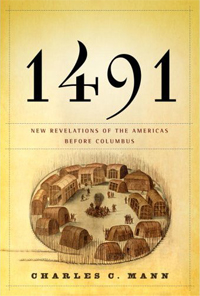Based on this program, if Spain Queen Elizabeth did not support Columbus to find a new way to India, the majority of America forests and fishes might still be there and more than 90% native American might not be dead.
Below is the information from National Geographic channel

History books traditionally depict the pre-Columbus Americas as a pristine wilderness where small native villages lived in harmony with nature. But scientific evidence tells a very different story: When Columbus stepped ashore in 1492, millions of people were already living there. America wasn't exactly a "New World," but a very old one whose inhabitants had built a vast infrastructure of cities, orchards, canals and causeways.
AMERICA BEFORE COLUMBUS
* The English brought honeybees to the Americas for honey, but the bees pollinated orchards along the East Coast. Thanks to the feral honeybees, many of the plants the Europeans brought, like apples and peaches, proliferated.
* Some 12,000 years ago, North American mammoths, ancient horses, and other large mammals vanished. The first horses in America since the Pleistocene era arrived with Columbus in 1493.
* Settlers in the Americas told of rivers that had more fish than water.
The South American potato helped spark a population explosion in Europe.
In 1491, the Americas had few domesticated animals, and used the llama as their beast of burden.
* In 1491, more people lived in the Americas than in Europe. The first conquistadors were sailors and adventurers.
* In 1492, the Americas were not a pristine wilderness but a crowded and managed landscape.
* The now barren Chaco Canyon was once covered with vegetation. Along with crops like wheat, weeds like dandelion were brought to America by Europeans.
It’s believed that the domestication of the turkey began in pre-Columbian Mexico, and did not exist in Europe in 1491.
* By 1500, European settlers and their plants and animals had altered much of the Americas’ landscape. While beans, potatoes, maize, tomato, (and pumpkin, turkey) from the Americas became major crops in continental Europe.
---------------------------
Below is information from wiki:

1491: New Revelations of the Native Americans Before Columbus is a 2005 non-fiction book by American author and science writer Charles C. Mann about the pre-Columbian Americas. The book argues that a combination of recent findings in different fields of research suggests that human populations in the Western Hemisphere — that is, the indigenous peoples of the Americas — were more numerous, had arrived earlier, were more sophisticated culturally, and controlled and shaped the natural landscape to a greater extent than scholars had previously thought.
The past 140 years have seen scientific revolutions in many fields, including demography, climatology, epidemiology, economics, botany, genetics, image analysis, palynology, molecular biology, biochemistry, and soil science. As new evidence has accumulated, long-standing views about the pre-Columbian world have been challenged and reexamined. Although there is no consensus, and Mann acknowledges controversies, Mann asserts that the general trend among scientists is to acknowledge:
1.(a) population levels in the Native Americans were probably higher than traditionally believed among scientists and closer to the number estimated by "high counters";
(b) humans probably arrived in the Americas earlier than thought, over the course of multiple waves of migration to the New World (not solely by the Bering land bridge over a relatively short period of time);
2. The level of cultural advancement and the settlement range of humans was higher and broader than previously imagined; and
3. The New World was not a wilderness at the time of European contact, but an environment which the indigenous peoples had altered for thousands of years for their benefit, mostly with fire.
No comments:
Post a Comment